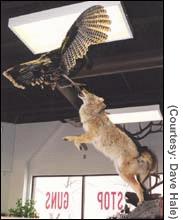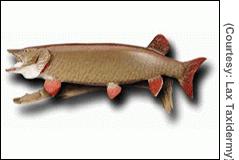|
Getting started: Taxidermy
|
 |
July 16, 2001: 10:10 a.m. ET
It takes a strong stomach and a creative eye to practice this art form
By Hope Hamashige
|
NEW YORK (CNNfn) - There's just one thing Cindy Crain wants the world to know about her chosen profession: It is not creepy Norman Bates types who stuff marlins and pheasants and white-tailed deer for a living.�
Oh, and that word, "stuff," just about makes Crain shudder when she hears it used to describe taxidermy. To "stuff" an animal harks back to the days when taxidermy was performed primarily by upholsterers who stuffed animal carcasses with leftover rags.
These days, she claims, taxidermy is a profession for neither the weird nor the morbid. Rather, said Crain, taxidermy is the domain of the artiste.
"People don't think of it as an art form and they should," she said. "It's an awesome thing to see a skin that is just laying there and you incorporate all your craft and artistic talent and look at this mount when you have completed it and it speaks to your heart."
Creativity pays off
All this is not to say there are no gross parts to the job. There are. And
taxidermists admit you have to have a pretty strong stomach for some of the things hunters drag into their studios. Many are hunters themselves and so were never squeamish about having to skin a dead animal.
But Crain likes to remind people that taxidermy has its roots not just in hunting but also in the museum business. Natural history museums have hired and still hire taxidermists to create nature displays that are lifelike and eye-catching.
That ability to draw on your creative reserves is one of the factors that sets an ordinary taxidermist apart from an extraordinary taxidermist. The days of simply mounting deer heads wooden placards are waning. While still in demand, the taxidermists who fetch top dollar are the ones who can put together a slightly more action packed wall mount.
The challenge is presentation. It's not enough for some customers to have their trophy bass mounted on a block of wood. They'd rather it look like it is flying out of a lily-pad laden lake, mouth wide open about to catch a dragonfly.
The popularity of traditional deer heads is being slowly displaced by the full body mount. The current challenge for taxidermists is to create new and interesting ways to present the trophies, such as at full gallop or locking horns with another deer.
According to Crain, creativity pays off. "If you are really good," she said, "it's not that hard to earn in the six figures."
Build a reputation
Like many in the business, Dave Hale, a taxidermist in Whitewood,

|
|
|
Dave Hale creation of coyote leaping after a turkey. | |
S.D., started as a hobbyist. He learned the trade by reading books and watching video tapes and showing his finished products to others who were already in the business. Many start this way, although there are several taxidermy schools, the best-known of which is the Northwestern School of Taxidermy.
During the past 15 years, Hale has worked up a reputation among local sports hunters as someone who is quick and reliable and does consistently good work. His business has grown every year, he said. Last year, he finished more than 300 so-called deer shoulder mounts, as well as many other pieces, and took in somewhere between $30,000 and $35,000. That is a modest sum, he noted, compared with some taxidermists who cater to wealthy big game hunters who bring in exotic trophies such as zebras.
Rick Lax, too, said reputation is everything in the taxidermy business. Lax went into business with his father 10 years ago at his studio in Conover, Wis. His father has been a taxidermist in the area for decades. Although they do some advertising in fishing magazines, Lax maintains that word of mouth is the strongest marketing tool for their family business.
"The hardest part about breaking in is showing people what you can do," said Lax, whose company specializes in lake fish like musky, pike and bass. "Our name has been around here for a long time and people feel secure with our work and we have clients who come back year after year."
Although the reputation is extremely important, the Lax's business is being fueled by both growth in demand and new products that are making taxidermy more efficient.
New opportunities; new materials
In the 10 years since Rick Lax joined his father's business, he has seen the business triple. And the biggest new market for them is a departure from traditional taxidermy. The Lax family is taking in more and

|
|
|
Lax Taxidermy makes replicas, like this one of a muskie, from photographs taken by fishermen. | |
more money from doing reproductions of fish rather than preserving the actual thing.
More fisherman are releasing rather than keeping their catch, said Lax, which created a new opportunity for the business. They started doing plastic reproductions, based on photographs submitted by fishermen, that serve as remembrances of the catch without having to kill the fish.
The Lax's began making reproductions six years ago and today it accounts for more than half their total business.
New materials have also made it possible for Hale to make and sell artificial antlers, also a departure from traditional taxidermy. Deer antlers taken from real animals, however, are really only for collectors who, according to Hale, pay up to $15,000 for a spectacular set of horns. His reproductions, which sell for $300 to $800, make antlers more affordable to more people.��
Other new developments have also been changing the industry, allowing taxidermists to be more productive and more creative in their work. The most oft-mentioned was the introduction of polyurethane manikins, the name for the form over which the skins are placed. The new manikins are much more lifelike than earlier incarnations, giving the taxidermists the freedom to concentrate on their artistry. It also makes them more productive because they can turn skins into finished products more quickly.
Likewise, said Crain, the glass eyes are more lifelike, and new materials also make it easier for taxidermists to make the eyelids and lips more lifelike as well.
"Everything is way, way modern," said Hale. "If you can't sew one up and make it look pretty real, you have a problem."
The challenge used to be to make the animals look as real as possible. The new materials have made that a lot easier and so taxidermists have to raise the bar in their creativity to set themselves apart.
"I really am only limited," said Hale, "by my own imagination." 
|
|
|
|
|
 |

|

